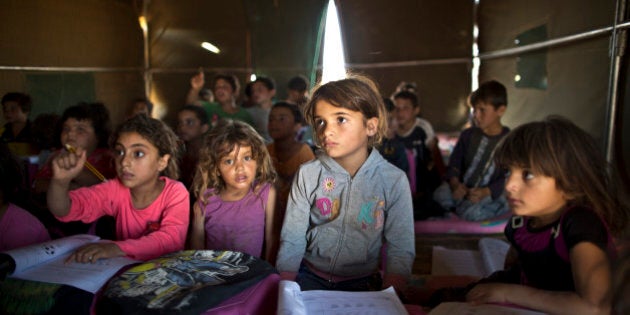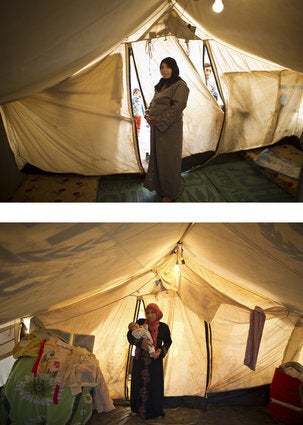
"The idea that some lives matter less is the root of all that is wrong with the world." Paul Farmer
One of the remarkable characteristics of children is that they remind us of our shared humanity. Children also possess an innate power, through their very existence alone, to incite compassion in even the most hardened of hearts. Perhaps that was the purpose behind yesterdays publication of the photograph of a young Syrian boy named Aylan, whose lifeless body had washed ashore while on a treacherous voyage to Greece. Aylan was dressed like many of his counterparts who would be starting preschool this month. Hours before the photo was taken, his loved ones may have secured the Velcro on his tiny shoes, and perhaps comforted him with words that many of us share with young ones: "it will be ok"; "don't be scared"; "we are almost there"; reassurance that ultimately proved futile. Just this morning we learned that Aylan's family was left with no choice but to embark on the deadly voyage, as Canada had reportedly denied their application for refugee status.
Few news organizations have published photos of refugee and migrant children, with some outlets even banning such photos, possibly as an attempt to dissuade support for these children and their families. Aylan's photo transcended the statistics we are often presented with, or the faceless stories behind tragedies such as the discovery of 71 dead refugees in Austria (of which 4 were children) or the children who later vanished from an Austrian hospital to join others in a desperate journey to safety.
It is far too easy to become lost in the daily reportage and statistics, and as such overlook the core issues facing the crisis. With respect to the longstanding crisis affecting refugee and migrant children, it is important to keep the following things in mind.
1.Terminology Matters
Refugees are those who are fleeing persecution and where return or repatriation may pose a reasonable threat of harm or even death. As per the 1951 United Nations' Convention relating to the Status of Refugees and the subsequent 1967 Protocol (of which Canada, the United States, and most European countries are signatories), the term "refugee" has a legal connotation (i.e. a responsibility to grant asylum).
There has been much debate around the use of the term "migrant" versus "refugee," with some news organizations abandoning the former term while reporting the current crisis. Indeed, both terms may be appropriate, as the numbers do not represent a homogenous group. As the UN High Commissioner for Refugees (UNHCR) has detailed, while a small proportion of people may be economic migrants, who do not face persecution in their country of origin, the vast number of migrants to the European Union (EU) may be classified as refugees. The UNHCR has provided a summary of this issue here. It is crucial to distinguish between these terms, as the needs of a migrant child generally, and a refugee child or a child seeking asylum specifically are very different, and have disparate connotations in local and international legislation as well as in various statutes that govern the rights of children.
2. The Convention on the Rights of the Child (CRC)
This CRC affords special protections for individuals under the age of 18. The CRC is crucial to uphold for all refugee and migrant children, and all European countries are signatories. The CRC further specifies that children's rights be upheld regardless of migration status or that of their parents. There are instances (such as the use of tear gas or barbed wire) where these rights are blatantly violated -- Article 19 in fact states that children be protected from physical and mental violence. Article 22 is the most relevant to the present crisis, as it speaks to the right to special protection for refugee children. Further, Articles 7 through 10 describe rights specific to registration, preservation of identity, separation and subsequent reunification. There are also a number of Articles that describe protection from exploitation and abuse, which can plague refugee and migrant children during their journey, or while in IDP or refugee camps. It is important to recognize that the United States (in addition to Somalia and South Sudan) has not ratified the CRC.
3.We Need to Revisit History
The philosopher Georg Hegel once remarked "we learn from history that we do not learn from history." Indeed, recent statements by British Foreign Secretary Philip Hammond sound eerily similar to the idea of "none is too many," a statement attributed to the former director of Canadian Immigration, Frederick Charles Blair (and echoed by other allied states), in an attempt to protest the migration of large numbers of Jewish refugees during World War II. As we now face the largest refugee crisis since World War II, the parallels are too close to ignore, and this is particularly true with respect to refugee and migrant children.
In World War II, there are a few key instances where protecting refugee children led to changes in legislation around immigration in general. For instance, Sir Nicholas Winton, who passed away this past July, was celebrated for his work in rescuing hundreds of Jewish children through a program called "Czech Kindertransport," by allowing for their safe passage into the UK. The British government eventually waived immigration restrictions for these children, many of whom would go on to be placed with British nationals. While today forced familial separation is rare, this history illustrates how prioritizing the safety of child migrants and refugees may be influential in affecting immigration policies that could benefit all migrants and refugees.
4. Many children may be separated from their families
We know that the vast majority of migrants and refugees attempting to enter Western Europe are from Syria, Serbia, Kosovo, Iraq, and Eritrea. While some children may be travelling with their immediate or extended family, still others may be unaccompanied. Stories such as the case of a 14 year-old Somali boy,who was violently beaten while working in Libya, and eventually succumbed to his injuries too often go undocumented and ignored. Unaccompanied children are at a higher risk of exploitation and abuse, and are thus particularly vulnerable and in need of additional protections.
5. Data on child migrants and refugees is limited
We know that almost half of the world's forcibly displaced people are children. The June UNHCR report indicates that the number of displaced people (refugees, internally displaced persons or asylum seekers) numbered up to 59.5million at the end of 2014. At least 4 million refugees have fled Syria over the last 4 years alone. We know at least 300 000 refugees and migrants have crossed the Mediterranean so far this year (exceeding 219 000 in all of 2014) and this is being updated almost daily by the International Organization for Migration (IOM) to also include deaths at sea.
All of the aforementioned estimates have increased, and we do not have concrete figures on the number of children affected. Some estimates place the numbers at one-half to one-third of all refugees and migrants, which would effectively mean at least 100 000 to 150 000 children entering Europe to date this year. Until registration systems are in place at the borders it will be unclear what proportion of refugees and migrants are children. These numbers are crucial to ensure humanitarian programs have the appropriate amount of supplies and resources while facilitating the preparation of host countries to receive these vulnerable children.
6. Migrant and Refugee Children have unique and diverse needs in their host country
Migrant and refugee children will require individual support to address all aspects of their health and wellbeing. Many children may have fled violence and persecution, which may only be further triggered by treatment at European borders.
A 2013 UNHCR report entitled "Future of Syria: children in crisis" detailed sleep difficulties, acute distress symptoms (such as flashbacks to war, bedwetting, constant crying), and speech issues, on top general health complaints and malnutrition affecting many refugee children. The lack of schooling, detailed so poignantly by UNHCR spokesperson Melissa Fleming last year, can lead to a "lost generation." The creation of safe spaces to play in areas such as Macedonia, where thousands of children are stranded while they await permission to transit through the country, are crucial to restore a sense of normalcy.
Once in their host country, many of these children will then go on to face further struggles with discrimination, stigmatization, financial insecurity, barriers around residency and citizenship status, and a disconnect between their home culture and traditions and that of the host country. While countries such as Germany and Sweden may have the resources to provide basic needs for migrants and refugees, they need to ensure that each child be appropriately assessed, and support be provided for reintegration and rehabilitation based on the needs identified.
7. Canada Can, and Should, Do More
The tragic loss of Aylan, along with his brother and mother, who were apparently denied asylum in Canada, can serve as an example of how Canada can no longer deny its role in resettling refugee children and their families. If Germany is willing to accept 800 000 refugees, surely Canada can rise above its commitment of a mere 10 000 over four years. As citizens, in an election year no less, we can critically evaluate the track record of refugee resettlement and hold our current and future electoral officials accountable to the promises made. Some Canadians are already opting to sponsor individuals privately or through a joint-assistance (shared sponsorship with the Canadian government) programs where children are listed as dependents (of note the age of dependency was recently lowered from 22 to 19). More information can be found here.
This past week a Syrian teacher migrating through Europe pleaded "you have to help us, we are human" and was later echoed by an Icelandic writer (who created a popular Facebook group for Icelanders to host Syrian refugees) who stated "[the refugees] are ...people of whom we'll never be able to say in the future: 'Your life is worth less than my life.' Both women echoed Dr. Farmer's poignant observation -- until privileged citizens recognize their own humanity in those fleeing war and conflict, the crisis will only continue to worsen. Children such as Aylan, as well countless others, remind us of this shared humanity, and our responsibility to each other during times of political turmoil. As our global history continues to teach us, uncertainty and violence on our planet can only be matched with equal parts compassion and committed action. An entire generation of children depends on it.
ALSO ON HUFFPOST:
